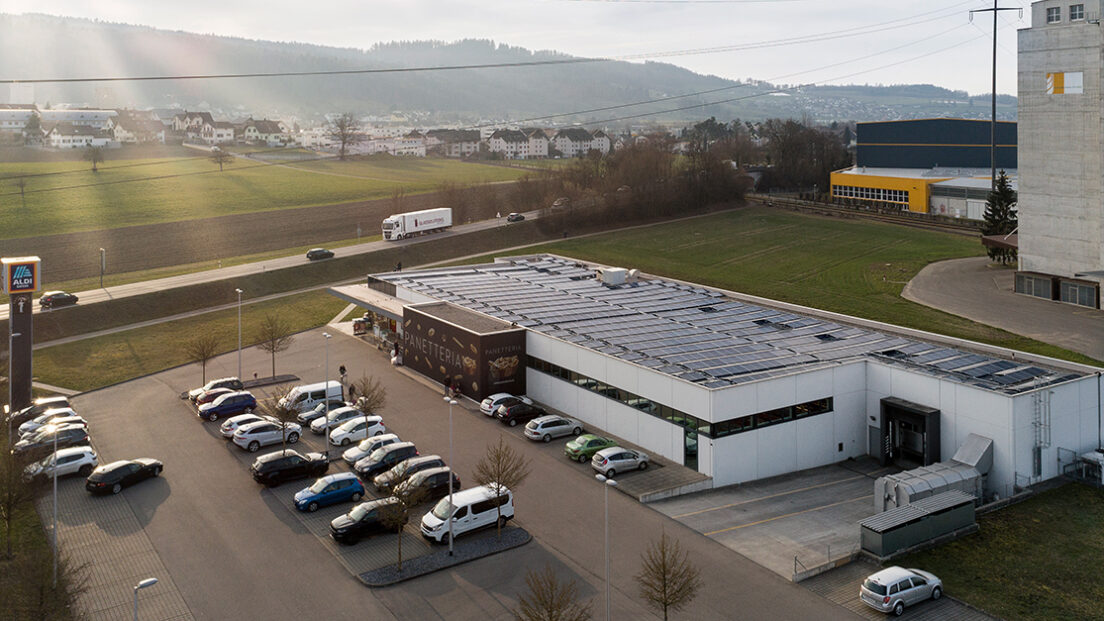Holistic solar solution for ALDI SUISSE

ALDI SUISSE carried out what is probably the most ambitious solar energy project in Switzerland: in just over a year, around 70 roofs between Romanshorn and Geneva were equipped with photovoltaic systems. ewz took over the planning, financing, implementation and operation.
The project is about sustainability and profitability: Photovoltaic systems with a total output of around 15,000 kWp were installed on around 70 store roofs. If you add up the systems, you get one of the largest solar energy projects in Switzerland. It will produce around 14 million kilowatt hours of electricity per year, which corresponds to the consumption of around 5,300 households. In this way, the retailer makes a valuable contribution to the sustainable energy supply in Switzerland – and at the same time can significantly reduce its operating costs.
The electricity from the systems is used by the shops themselves, which – like all retailers – consume a relatively large amount of energy because of the many refrigerated shelves, the oven, the heating and the lighting. In addition, where available, the solar power is used in the e-charging stations next to the branches and, if there is excess, fed into the grid.
Time pressure as a challenge and opportunity
At the end of 2019, ewz Energy Solutions was awarded the contract to build the systems. In close cooperation, ewz developed a pilot system with its subsidiary SunTechnics Fabrisolar and another partner. This procedure made it possible to use the know-how of all those involved and to clarify technical questions in advance. ALDI SUISSE’s extensive requirements for the construction process, safety requirements and functionality were also taken into account. ewz prepared the rollout during the pilot phase and continuously incorporated the findings from the construction of the first systems. The time pressure thus proved not only to be a major challenge, but also an opportunity. Because of the almost simultaneous construction of the 70 or so plants, many synergies could be used, which enabled efficient implementation.
Elaborate static test
Before the modules were installed, each roof had to be statically tested. This is particularly important for existing buildings, as the additional loads from modules, fastening systems and cast concrete blocks are high. For each store roof, the specialists used calculation software to create a ballast plan that specifies the number and positioning of the modules. The modules are usually set up in an east-west direction. A southern orientation would also be possible in principle due to the high direct solar radiation at midday, but over the course of the day the east-west orientation proves to be more profitable.
Maximum solar yield
“When planning, we didn’t look at the size of the house connection, but at the available roof area and the maximum number of modules we could place there,” says Roland Jucker, overall project manager at ewz. The goal of ewz was clearly to generate as much solar yield as possible. However, this fundamental decision presented the planners with a number of challenges. The biggest was to integrate the PV system into the existing power supply of the branches.
The electricity produced by the PV system is primarily used directly in the ALDI branch to cover its own consumption. If the branch is using less electricity than the PV system is producing, the excess electricity is fed into the grid. The electrical house connection must therefore be matched to the maximum output of the PV system (e.g. sunny Sunday with maximum production and low self-consumption). However, because this situation occurs extremely rarely and only for a short time, strengthening the house connection would be disproportionately expensive.
The solution is dynamic power control. It is constantly measured how much electricity the PV system is currently producing, what the consumers are drawing and how much electricity is being fed back into the grid. If the feedback current is above a certain limit, the control unit gives the command to the inverter to throttle the power. The house connection fuse cannot be overloaded and self-consumption is not restricted.
Thanks to the large PV systems, the solution implemented for ALDI SUISSE enables a very high solar yield with an average self-consumption of around 60 percent.
ALDI SUISSE has concluded a contracting agreement with ewz
To put it simply: ALDI SUISSE provides the roofs and, as far as possible, obtains the solar power to cover the electricity consumption directly in the branch. The PV systems belong to ewz, which is also responsible for maintenance, billing and renewal. The “carefree package” also includes the overall coordination of the project, obtaining building permits, remote monitoring and the use of residual electricity.
Roland Jucker, overall project manager at ewz says: “The idea of equipping as many roofs as possible with a standardized PV solution is visionary”. “In the end, around 45,000 modules were installed.” Jucker is particularly proud of the fact that the installation was able to take place during ongoing operations. “We had to be off the network for 30 minutes after closing time – that was the only interruption.”
Christoph Deiss, Head of the Energy Solutions division at ewz, says: “I am not aware of a similar project in Switzerland. In this way, ALDI SUISSE is making a valuable contribution to climate protection together with us.» Christoph Deiss emphasizes the great experience: “We have been using photovoltaic technology for over 30 years – we have been a solar pioneer from the very beginning.” Thanks to its great know-how and many years of experience, ewz prevailed against around a dozen competitors in the tender. “ewz is a Swiss company with locations in Zurich, Graubünden and Vaud,” emphasizes Christoph Deiss. “Thanks to the regional operating teams, we guarantee the highest security of supply and short response times.”
Further information at: ewz.ch/aldisuisse